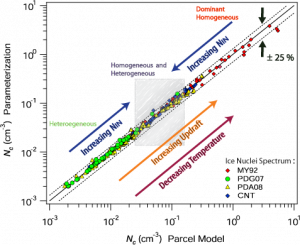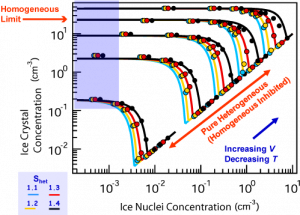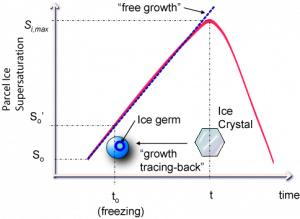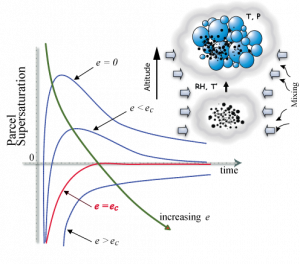Development of Cloud Microphysical Parameterizations for large-scale models
Many global modeling studies of the aerosol indirect effect use empirical parameterization that link aerosol to cloud microphysical quantities (e.g., cloud droplet number, ice crystal number concentration, effect radius and spectral width). We develop physical parameterizations that describe basic cloud processes, such as droplet/ice nucleation and growth, collision-coalescence and their implementation that considers the subgrid-scale variability of dynamics and liquid water content.
Some characteristic examples follow with recent work out of the group (courtesy of D.Barahona).
Competition between Homogeneous and Heterogeneous Freezing – Polydisperse Aerosol
Donifan Barahona and Athanasios Nenes. Atmos. Chem. Phys., 9, 5933-5948, 2009

Aerosol in the atmosphere is chemically heterogeneous and polydisperse.Calculation of the ice crystal concentration, Nc, for this case is notelemental, as polydisperse aerosol may freeze continuously during cloud formation. This difficulty is overcome by writing the mass and energy balances of the cloudy parcel in terms of the “freezing nucleation spectrum”, ns(si , T, Naerosol ,…). We have developed a highly versatile and accurate analytical parameterization that can use any definition of ns accounting for effects of temperature, pressure, aerosol concentration and size, and freezing mode. Compared to the full numerical solution, the average error of the parameterization is below 2%.
Competition between Homogeneous and Heterogeneous Freezing – Monodisperse Aerosol
Donifan Barahona and Athanasios Nenes. Atmos. Chem. Phys., 9, 369-381, 2009

Freezing of aerosol with a single freezing threshold can be thought as the freezing of a monodisperse, chemically homogeneous aerosolpopulation. The best example of this would be the immersion freezing of a liquid solution with insoluble solid immersions of the same size and type. Using this approximation we have developed a parameterization to calculate the ice crystal concentration, Nc, accounting for the competition between homogeneous and heterogeneous freezing. We demonstrated that IN concentrations as low as 1 L-1 can greatly impact cirrus cloud properties. The Figure shows Nc as a function of the IN concentration for different updraft velocities (from low to high 0.04, 0.2, 0.5, 1, 2 ms-1).
Ice Crystal Concentration and Size Distribution from Homogeneous Freezing
Donifan Barahona and Athanasios Nenes. J. Geophys. Res., 113, D11211, 2008

Homogeneous freezing is ubiquitous in the atmosphere; it is the main mechanism for the formation of cirrus clouds. We have developed anumerical model based on the novel “Lagrangian particle tracking scheme” that solves the equations associated with the formation of cirrus clouds. In this scheme, the cloud ice crystal population is considered a superposition of monodisperse ice crystal populations, each of which represents the fraction of droplets frozen at each time step. Using this concept (shown in the Figure) we have developed analytical expressions to calculate the ice crystal size distribution and concentration from the homogeneous freezing of droplets.
Cloud Droplet Activation and Entrainment: The Critical Entrainment Rate
Donifan Barahona and Athanasios Nenes J. Geophys. Res., 112, D16206, 2007

Liquid clouds form by aerosol activation at relative humidity slightly above 100%. Supersaturation is generated by a subtle balance between water vapor condensation and expansion cooling. The rate of generation of supersaturation is greatlyinfluenced by mixing with the surrounding dry air. The intensity of mixing is measured by the entrainment rate (e); we have discovered that there is a limiting value for e termed the critical entrainment rate, ec, for which supersaturation is never achieved . Mixing effects on activation can be easily accounted by using ec as an scaling factor. Thus, mixing and entrainment can be easily included in the description of cloud formation in large scale atmospheric models.
Evaluation of Cloud Microphysical Parameterizations using in-situ observations
All the microphysical parameterizations have been evaluated against a numerical cloud parcel model for their accuracy; ultimately they need to reproduce the properties of clouds. Therefore it is very important to evaluate them against in-situ datasets. Our group has a very active field campaign program, but we are very active in using this (and other) data to evaluate microphysical parameterizations.